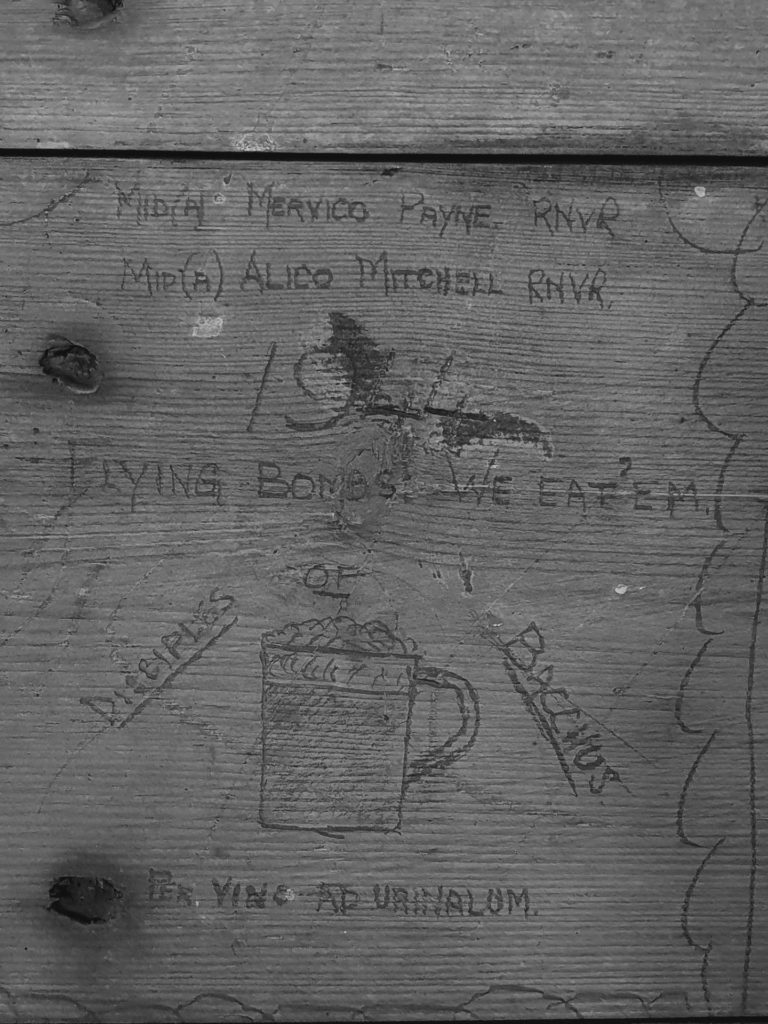Wartime graffiti in the Chapel dome – The Disciples of Bacchus
Mon 19 Feb 24
World War II brought with it many challenges and sacrifices for those serving in the armed forces. Amid the grim backdrop of global conflict, tales of camaraderie, mischief, and youthful exuberance still managed to emerge.
The Chapel dome, now accessible to the public via Secret Dome Tours, is filled with reminders of the young servicemen stationed on the site. One such story features two young Royal Naval College trainees, Mervyn Payne and Alexander Mitchell, who etched their names in history through graffiti and daring wartime service.
The Fire Watch and Graffiti
During World War II, the fire watch was an essential duty assigned to trainees at the Royal Naval College. Fire watchers were posted on all the rooftops, including in the dome of the Chapel of St Peter & St Paul, from where the Chapel bell was rung as a warning. While living at Greenwich during the heaviest raids was an unsettling experience, the duty shift sometimes tested the patience of those on fire watch during quiet periods. While the task may have seemed tedious to some, it provided ample opportunities for a bit of mischief. As history would have it, Mervyn Payne and Alexander Mitchell, both Midshipmen in the Royal Naval Volunteer Reserve (RNVR), seized this chance to make their mark.
Forever etched on the dome’s clock casing is a piece of graffiti that continues to captivate the imagination. Featuring cod Latin, the inscription, dated 1944, by the self-styled “Disciples of Bacchus,” Mid (A) Mervico Payne RNVR and Mid (A) Alico Mitchell RNVR, proudly proclaimed, “Flying bombs we eat ’em,” accompanied by what appears to be a frothy mug of beer. The subtitle, ‘per vino ad urinalum,’ which translates to ‘from wine to urine’, hints at their cheeky mockery of the strict naval decorum that surrounded them.

From their graffiti (and later confirmed), we can see that both men were Midshipman (Mid) and were part of the Royal Naval Volunteer Reserve (RNVR). The ‘A’ indicated Air Branch and likely hinted at their roles as pilots.
Mervyn H. Payne: The Flying Seafire
Mervyn H. Payne, the enigmatic Mervico, was born in 1925 in Newton le Willows, Lancashire (now Merseyside). Based at HMS Macaw, a Fleet Air Arm base in Cumbria, he was around 19 during his time training at Greenwich for the Sub-Lieutenant course.
Mervyn’s journey took him to HMS Implacable, where he became a member of the renowned 801 squadron, established in 1933. Records indicate that Mervyn piloted a Seafire LIII, a naval adaptation of the iconic Supermarine Spitfire. These aircraft played a pivotal role in the Pacific Theater of the war, culminating in Victory over Japan (VJ Day) in August 1945.
Tragically, Mervyn Payne did not live to witness the war’s end. On June 14th, during Operation Inmate, he and his Seafire, bearing the serial number PP975, were shot down in a strafing attack on a Japanese airfield over Truk Lagoon in Micronesia. He was declared missing, presumed killed (MPK), becoming the sole Allied casualty of that fateful day. His memory lives on at the war memorial in Lee-on-Solent, Hampshire. Mervyn Payne was just 20 years old when he made the ultimate sacrifice.
Alexander Mitchell: A Mystery Unsolved
While Mervyn Payne’s wartime journey and sacrifice are well-documented, his partner in mischief, Alexander Mitchell, remains shrouded in mystery. Known to be stationed at HMS Dipper in Henstridge, Dorset, and attending the sub-Lieutenant course at the Royal Naval College in 1944, Alexander Mitchell’s trail goes cold after his time at Greenwich.
The details of his service and post-war life remain elusive, leaving us with unanswered questions about the fate of this intriguing character. If you possess any information about Alexander Mitchell, we encourage you to come forward and help us complete this cordial wartime narrative.
The story of Mervyn Payne and Alexander Mitchell, the two mischievous trainees at the Royal Naval College, offers a glimpse into the human side of a tumultuous era. Their graffiti may have been a lighthearted rebellion against the constraints of wartime life, but their service and sacrifice reflect the courage and resilience of an entire generation. As we honour their memory, we also seek to unravel the enigma surrounding Alexander Mitchell, ensuring that his role in this remarkable tale is not forgotten in the annals of history.
Tickets for our Secret Dome Tours for 2024 are now on sale. Book now to discover the many secrets hiding in this remarkable space, rarely open to the public.
Research and writing contributions by Judith Scott (Team Leader).


